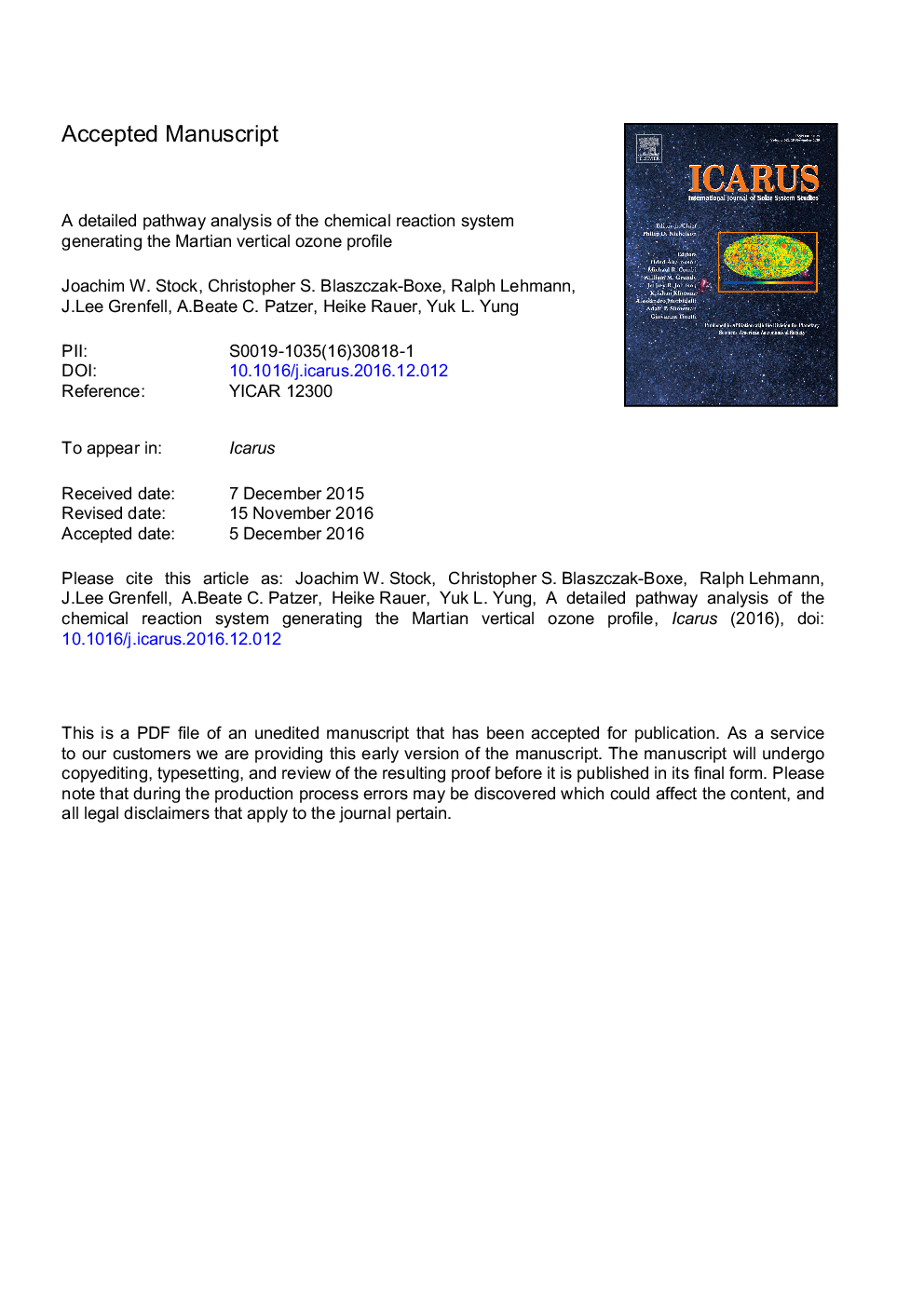| کد مقاله | کد نشریه | سال انتشار | مقاله انگلیسی | نسخه تمام متن |
|---|---|---|---|---|
| 5487446 | 1523500 | 2017 | 15 صفحه PDF | دانلود رایگان |
عنوان انگلیسی مقاله ISI
A detailed pathway analysis of the chemical reaction system generating the Martian vertical ozone profile
ترجمه فارسی عنوان
تجزیه و تحلیل مسیر دقیق از سیستم واکنش شیمیایی تولید پروفیل عمودی مریخ
دانلود مقاله + سفارش ترجمه
دانلود مقاله ISI انگلیسی
رایگان برای ایرانیان
کلمات کلیدی
جوی شیمی، ترکیب اتمسفری، مریخ، فضای مریخ، فتوشیمی،
موضوعات مرتبط
مهندسی و علوم پایه
علوم زمین و سیارات
علوم فضا و نجوم
چکیده انگلیسی
Atmospheric chemical composition is crucial in determining a planet's atmospheric structure, stability, and evolution. Attaining a quantitative understanding of the essential chemical mechanisms governing atmospheric composition is nontrivial due to complex interactions between chemical species. Trace species, for example, can participate in catalytic cycles - affecting the abundance of major and other trace gas species. Specifically, for Mars, such cycles dictate the abundance of its primary atmospheric constituent, carbon dioxide (CO2), but also for one of its trace gases, ozone (O3). The identification of chemical pathways/cycles by hand is extremely demanding; hence, the application of numerical methods, such as the Pathway Analysis Program (PAP), is crucial to analyze and quantitatively exemplify chemical reaction networks. Here, we carry out the first automated quantitative chemical pathway analysis of Mars' atmosphere with respect to O3. PAP was applied to JPL/Caltech's 1-D updated photochemical Mars model's output data. We determine all significant chemical pathways and their contribution to O3 production and consumption (up to 80âkm) in order to investigate the mechanisms causing the characteristic shape of the O3 volume mixing ratio profile, i.e. a ground layer maximum and an ozone layer at â¼50âkm. These pathways explain why an O3 layer is present, why it is located at that particular altitude and what the different processes forming the near-surface and middle atmosphere O3 maxima are. Furthermore, we show that the Martian atmosphere can be divided into two chemically distinct regions according to the O(3P):O3 ratio. In the lower region (below approximately 24âkm altitude) O3 is the most abundant Ox (=Â O3Â +Â O(3P)) species. In the upper region (above approximately 24âkm altitude), where the O3 layer is located, O(3P) is the most abundant Ox species. Earlier results concerning the formation of O3 on Mars can now be explained with the help of chemical pathways leading to a better understanding of the vertical O3 profile.
ناشر
Database: Elsevier - ScienceDirect (ساینس دایرکت)
Journal: Icarus - Volume 291, 15 July 2017, Pages 192-202
Journal: Icarus - Volume 291, 15 July 2017, Pages 192-202
نویسندگان
Joachim W. Stock, Christopher S. Blaszczak-Boxe, Ralph Lehmann, J. Lee Grenfell, A. Beate C. Patzer, Heike Rauer, Yuk L. Yung,
